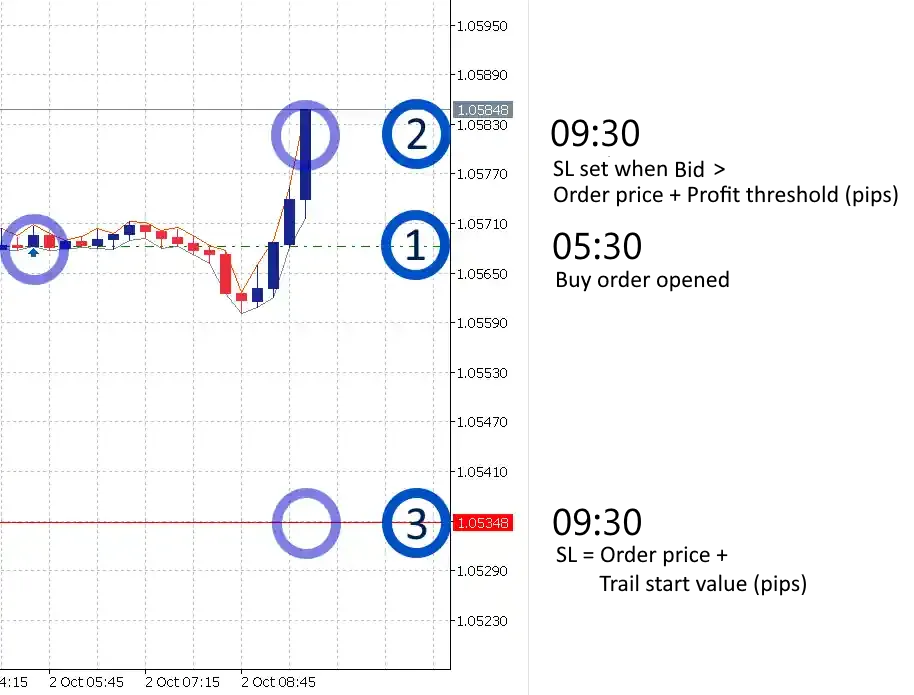Stop loss - Trailing
The Stop loss - Trailing – Close module, will not set a stop loss (SL) directly after opening an order (see ‘1’ in image below), but will wait for the price to hit the threshold (see ‘2’ in image below). Only then the stop loss (SL) is set (see ‘3’ in image below). If the price hits the SL, the module closes the order. The module sets the SL of a buy order below the current price, not necessarily below the buy order’s open price. Because the SL is set below the current price, it’s possible that when the SL gets hit, the order is in profit; it’s also possible because of trailing. Many traders use this module to capture profits the moment the price retraces. For a sell order, everything is in reverse, so the module sets the SL of a sell order above the current price.

Settings
Section titled “Settings”Profit threshold (pips): this is the threshold (in pips) an order has to hit, before the SL is set and the SL starts trailing. Before the threshold is hit, the module will have no effect.
Example: if this value is set to 30, then the SL will be set (and the trailing will start) when the order has a profit of 30 pips.Trail start value (pips): the amount of pips where the SL starts trailing. The SL is set at: Open price + Trail start value (pips).
Examples: if set to -20, the SL is set to 20 pips of loss. If set to 0, the SL is set to break-even. If set to 20, the SL is set to 20 pips of profit.Trail step size: the amount the trail will gain when the order gains new highs. Let’s assume you put the setting to 1. If the profit increases 1 pip above the threshold value, the trail will move 1 pip up as well. If the setting is set to 2, SL will go up 2 pips for every pip of additional profit, instead of 1.
Trail minimum distance (pips): the trail will not get closer in pips to the current price than set, in pips. This is useful when using a Trail step size bigger than 1 and you want the trail to keep a certain distance from the current price. Warning: when set to 0 or any negative number, the trail will be allowed to overtake the current price, causing the order to close before retracing.
Example: You have a Profit Threshold of 30 pips and you set the Trail start value (pips) to 20. You have a Trail step size of 1. The trail will now always be 10 pips behind the current price. However, if you have a step 10 and the price goes up 1 pip, then the trail will now be at:
Current profit - Trail start value (pips) + (Trail step size * profit movement) =
31 - 20 + (10 * 1) = 30
So the trail is 1 pip behind the current price. If the market goes up one more pip, the trail will still be 1 pip behind the market price, because the minimum distance is set to 1 pip. If you would have a Trail minimum distance (pips) of 0.1 pip then the trail would now be 0.1 pip behind the current price. If you would put Trail minimum distance (pips) to 0, the SL can match the current price and the SL can be hit even though the price never retraced. So, if you don’t want an order to get closed when the order is gaining new highs, then use a value of 0.1 or higher.